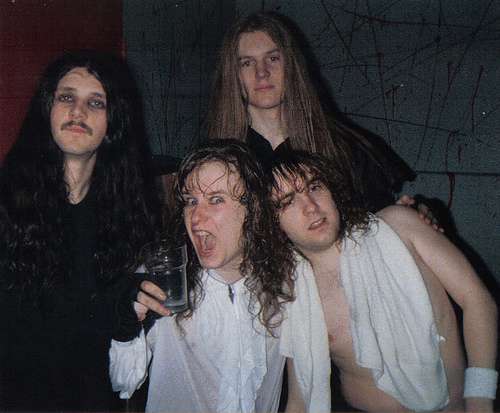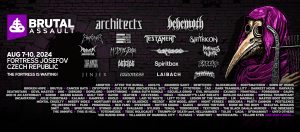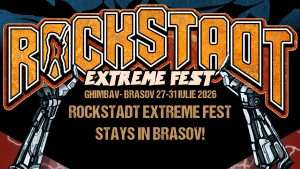Dreamweaver: Sabbat’s bombastic album that stands the test of time (1989, Noise Records)
An album that still sounds as fresh as the day it was released.

Nowadays we are used to mixing all types of genres without any qualms and often it does not need any justification, it is something we already take for granted. However, looking back three or four decades, it is surprising how many bands started doing it without any kind of precedent and succeeded in one way or another, although it was not always like that.
The case of Sabbat is very special, since the British quintet would end up splitting up some time later and would give rise to another of those bands completely removed from their time with a very particular vision of the metal universe, Skyclad, considered one of the pioneers of folk. metal that years later we would end up running out of
Hydra would be the germ of what would later be known as Sabbat, a project formed in 1985 by vocalist Martin Walkyier and bassist Frazer Craske, to which the renowned guitarist and currently producer Andy Sneap would join shortly after. The recruitment of Sneap would be the replacement that both Walkyier and Craske were looking for, since they needed the incorporation of a second guitarist and curiously it would be at a Hell concert where the two members of Hydra would meet Sneap, whom they would recruit at the early age of fifteen.
In 1985 they recorded their first demo as Sabbat with Mark Daley, which they called Magick in Theory and Practice, released on cassette and distributed by the band themselves in the United Kingdom, with guitarist Andy Sneap. The last step would be to recruit drummer Simon Negus who would replace Mark Daley, with whom they recorded this first demo. The person in charge of introducing the former drummer of Striptease and Fallen Angel would be Tim Bowler, drummer of Hell, and coinciding with all these changes, the final line-up of Sabbat would be closed, with which they would record three of the best albums of the genre to date
In 1986 they returned to the studio to record Fragments of a Faith Forgotten, another demo composed of three new, completely unreleased songs that would be part of their debut album, History of a Time to Come. Before entering the studio to give life to their debut album, they would record a third demo titled Stranger than Fiction, composed of the title track of the demo itself and The Original Sin, two unreleased songs that would not be part of their debut album and that Initially they were going to be released in single format, although this idea was discarded and these songs were forgotten.
With the distribution of Fragments of a Faith Forgotten to several renowned media and labels, Andy Sneap caught the attention of Noise Records in mid-1986 and they asked for more material to check the quality of their compositions. Sabbat had recorded a session at the BBC’s Maida Vale Studios for the Friday Rock Show with the intention of having Tommy Vance review their material on Metal Hammer, so they sent a copy of those sessions to Noise Records and quickly received a contract. by the German label in March 1987. The band agreed to sign the contract, but they had to wait for Sneap to turn eighteen in July of that year to be able to sign with Noise.

Sabbat then receives an offer from John Blanche, art director of White Dwarf magazine, proposing that the band record a song that would be released on a flexi disc that would accompany the launch of the magazine. Sabbat then accessed and recorded Blood for the Blood God in August 1987, whose song would be distributed in the magazine White Dwarf, released in November of that same year for free
By September of that year they traveled to Hannover (Germany) to enter the Horus Sound studios and give life to History of a Time to Come, their debut album influenced by paganism, occultism and religion, addressing topics as interesting as the passion of Hitler for the occult in Behind the Crooked Cross, the fall of Lucifer in I for an Eye, the last fight between heaven and hell according to the Bible in Hosanna in Excelsis or the inquisition during the Middle Ages in For those who Died. The album would be recorded in September of that same year and would be mixed by producer Roy M. Rowland. His previous contact with John Blanche of White Dwarf magazine would result in the colossal cover of his debut album, which the author would title Horned is the Hunter – like the album’s theme itself
The success of their debut album would lead them to open a couple of UDO concerts, although the rest of the tour would later be cancelled. During 1988 they would share the stage with other emerging bands such as Candlemass, Kingdom Come, Sacrilege, Lawnmower Deth, Assassin or Rage, in addition to having shared the stage with Running Wild, Toranaga, Risk, Exodus, Lȧȧz Rockit, Toxik and Paradox.
Hoping to top an album as devastating as History of a Time to Come, the next step in Sabbat‘s career is to compose and record a concept album based on the book The Way of Wyrd: Tales of an Anglo-Saxon Sorcerer by the British psychologist Brian Bates, published in 1983. The work in question is based on the wyrd, a concept from Anglo-Saxon culture that has no translation but would come to mean destiny or personal fate, how past actions continually influence and condition the future.
Between January and March 1989 Sabbat made the Sky Trak Studio in Berlin their second home to give life to his tremendous Dreamweaver (Reflections of our Yesterdays) album, a colossal work of progressive thrash in which Roy M. Rowland repeats as producer and who is joined by Karl-Ulrich Walterbach as executive producer. During the recording of the album, Simon Jones joins the band to help Sneap in his work as a guitarist whose perfectionism leads him to increase the amount of technicality in his compositions, giving rise to a much more complex album in musical terms in which the genre progressive is gaining ground in the sound of Sabbat.
After two months of hard work, Dreamweaver was released in May 1989 again under the Noise Records label, and despite never having been considered one of the most important releases of the genre, it is able to please the press and public alike. The hard work of its members is rewarded with the most favorable reviews and the band embarks on a tour throughout the United Kingdom sharing the stage with another of the greatest banners of British thrash, Xentrix, who at that time was presenting Shattered Existence, another album that we will talk about in the future.
Things should have been very bad for Sabbat for everything to go wrong with Dreamweaver, but luckily everything went as planned. Manowar was at the top at that time presenting Kings of Metal all over the world and Sabbat was the band chosen to open their concerts in Europe. They started the tour at the Barcelona Sports Palace, passed through the Real Madrid Pavilion and ended their trip around Spain at the Anoeta Velodrome (San Sebastián) between November 30 and December 2, 1989. One month later they were sharing the stage with Toranaga, Fates Warning, Saxon and Lizzy Borden alongside Manowar.

As for the theme of the album, it all revolves around the figure of Wat Brand, a Christian missionary from the North of England who is sent to the South of the country a long time ago to study and learn the pagan culture of the Anglo-Saxons, although Its real objective is to convert its inhabitants into Christians, as narrated in the title that opens this magnum opus, The Clerical Conspiracy.
Brand travels to the south of the country along the coast, taking stock of everything he has left behind and what awaits him in the future, questioning whether he has chosen the right path. Meanwhile he manages to reach the South and, while waiting for his guide to arrive, he is visited by pagan spirits who try to find out if the objective of Brand‘s visit is to destroy the old gods to impose the new religion on them, narrated with the grotesque voice of Walkyier in Advent of Insanity and Do Dark Horses Dream of Nightmares?. Up to this point, the quality of the members’ compositions is enormously surprising, but what really drives me crazy about Dreamweaver is the sound that Andy Sneap and Simon Jones manage to get out of their guitars, it is something from another world
Although the duration of these first two cuts is normal within the genre, although it is not the most common, it is from The Best of Enemies onwards that Sabbat begins to reformulate technical thrash, sensibly stretching the duration of the songs that easily go to eight minutes as in the aforementioned case and in How Have the Mighty Fallen?, where Brand‘s journey is resumed the morning after his nightmare, when he finally meets Wulf, his guide, who tells him about pagan customs and He begins to question why Brand has come to the South of England. Walkyier here alternates the dialogue between Wulf and Brand simultaneously with his powerful voice. Wulf talks to Brand and tells him that if he really wants to learn about pagan culture he has to find it for himself and he has to meet the spirits face to face, that the spirits will give him all the knowledge he wants only if he has the conviction to follow. forward. What Brand doesn’t know is that Wulf is actually a shaman priest.
The story switches sides with sharp, frenetic guitars on How Have the Mighty Fallen? narrating Brand‘s first real encounter with the spirits from the latter’s perspective. Walkyier perfectly describes Brand’s attempt to deviate from the path he must take and the preparations he must make to meet the spirits and they end up arriving ahead of time, stealing his soul and warning Brand that to recover it he must travel to the world. of the spirits to recover it in less than two days, or its life force will be exhausted. All this is broken down into eight minutes of pure technical thrash in which the brutal rhythmic base of Simon Negus and Frazer Craske on drums and bass stands out, on which a solid rhythm is based on which a brilliant Andy Sneap is able to get away of technicality to deliver melodic and heartfelt solos within an atmosphere of oppression and chaos.
Brand‘s journey advances without thematic introductions, but he enters fully into the world of spirits with the powerful Wildfire in which his protagonist must dance naked between two fires to end up finding his own soul, which is a woman, as we are told. in the powerful Mythystory. Here we are faced with the perfect combination of speed and aggressiveness, stepping on and releasing the accelerator pedal intermittently to explain how Brand ignores that the woman he has met is his own soul. Likewise, the woman makes him understand that she is the one who has come to search and that he should stop searching since he can now return to the material world to learn everything he wants about the wyrd. What Brand does not know is that this trip has not served to convert pagans into Christians, but rather to discover himself as Wyrd himself intends
Brand‘s journey comes to an end with Happy Never After after having understood the reasons that have led him to his current situation, completely ignoring the purpose for which he had descended from the North of England to absorb and surrender to a new style of life thanks to what he had come to destroy. This is how Sabbat became one of those cult bands that every lover of the genre should revere by now. Alternating history and music without any additives, giving himself body and soul to a cause like the one that unites us: heavy metal.





![amorphis-presentan-nuevo-sencillo-light-and-shadow-de-nuevo-album-borderland-1849[1]](https://alliedforces.es/wp-content/uploads/2025/08/amorphis-presentan-nuevo-sencillo-light-and-shadow-de-nuevo-album-borderland-18491-300x159.jpg)



